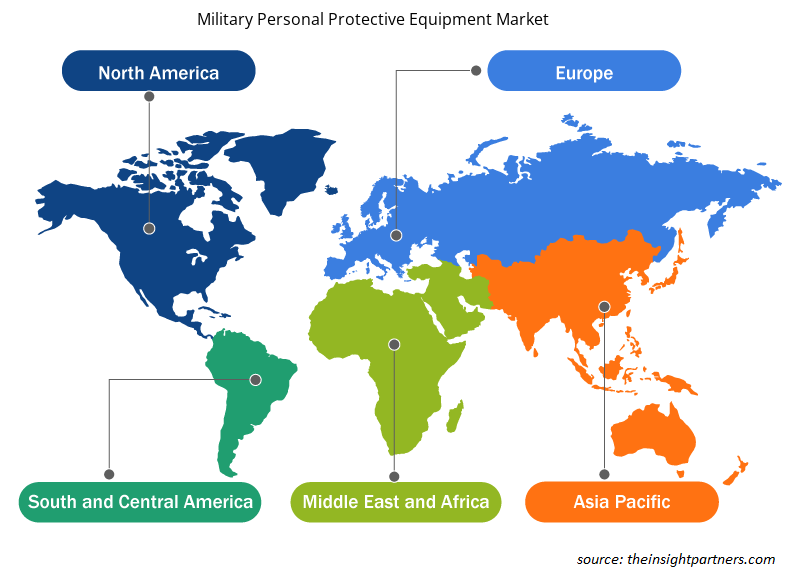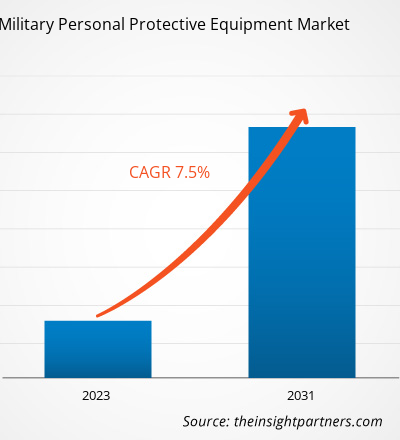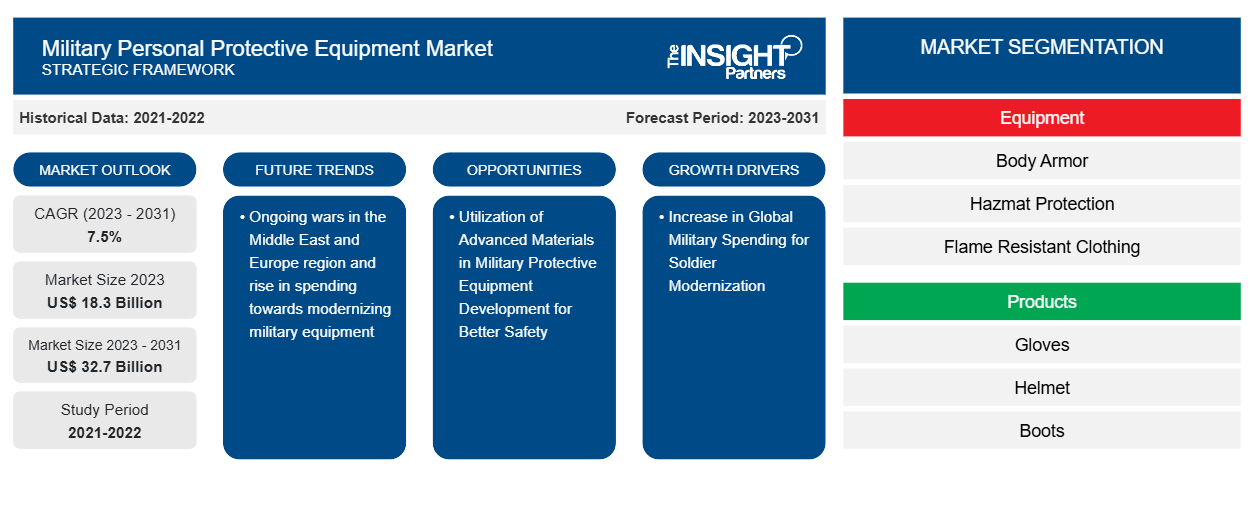Se proyecta que el tamaño del mercado de equipos de protección personal militar alcance los 32.700 millones de dólares estadounidenses en 2031, frente a los 18.300 millones de dólares estadounidenses en 2023. Se espera que el mercado registre una CAGR del 7,5 % entre 2023 y 2031. Las guerras en curso en la región de Oriente Medio y Europa y el aumento del gasto en modernización de equipos militares y garantía de la seguridad del personal militar se encuentran entre los factores clave que impulsan el mercado de equipos de protección personal militar.
Análisis del mercado de equipos de protección personal militar
El crecimiento de los equipos de protección personal militar en todo el mundo se debe principalmente al aumento de los presupuestos de defensa y a los crecientes esfuerzos de modernización de los soldados militares. Además, la creciente demanda de diversos equipos militares está aumentando a medida que los gobiernos de todo el mundo se centran cada vez más en la modernización de los soldados debido a las crecientes preocupaciones por la seguridad. Se espera que la complejidad sostenida e incierta del entorno de seguridad internacional en todo el mundo impulse el gasto en defensa de las autoridades de la región durante los próximos cinco años. Además, las empresas de todo el mundo están muy involucradas en el diseño y suministro de equipos de protección personal militar, lo que a su vez se prevé que impulse el crecimiento del mercado en los próximos años. Algunas de las empresas dedicadas al diseño de equipos de protección personal militar son Ceradyne (3M), Honeywell International, BAE Systems, DuPont y Ansell Ltd., entre otras.
Descripción general del mercado de equipos de protección personal militar
En el pasado reciente, la demanda de equipos de protección personal militar aumentó debido a la situación de guerra en Afganistán, Irak, Libia y Serbia. Además, la creciente producción nuclear de Irán ha intensificado las tensiones militares entre Estados Unidos, Israel e Irán. La creciente demanda de equipos de protección avanzados en diferentes fuerzas militares es un factor importante que impulsa el crecimiento del mercado de equipos de protección personal (EPP) militar. Los cinco principales gastadores militares en el año 2023 son Estados Unidos, China, India, Arabia Saudita y Rusia, que impulsan la adquisición de equipos de protección personal militar en estos países. Se proyecta que la demanda de equipos de protección personal militar sea impulsada por las iniciativas de modernización de los grandes financistas de defensa en Estados Unidos y las amenazas a la seguridad interna, como el terrorismo organizado y el crimen. Además, un aumento significativo de las tensiones transfronterizas entre India, China y Pakistán está impulsando el crecimiento del mercado de equipos de protección personal (EPP) militar en Asia Pacífico.
Personalice este informe según sus necesidades
Obtendrá personalización en cualquier informe, sin cargo, incluidas partes de este informe o análisis a nivel de país, paquete de datos de Excel, así como también grandes ofertas y descuentos para empresas emergentes y universidades.
- Obtenga las principales tendencias clave del mercado de este informe.Esta muestra GRATUITA incluirá análisis de datos, desde tendencias del mercado hasta estimaciones y pronósticos.
Factores impulsores y oportunidades del mercado de equipos de protección personal militar
Aumento del gasto militar mundial para la modernización de los soldados
El combate moderno conduce a varios enfrentamientos de escenarios complejos en el campo de batalla; por lo tanto, los soldados se enfrentan a una amplia variedad de amenazas, como artefactos explosivos improvisados (IED) y ataques con granadas propulsadas por cohetes. Estas amenazas permiten un aumento en la demanda de diferentes EPI, como cascos , gafas de visión nocturna, chalecos antibalas y ropa, que brindan mayor protección y conocimiento de la situación a los soldados. Además, para satisfacer la demanda de modernización y seguridad de los soldados, los gobiernos y las asociaciones de todo el mundo están aumentando la financiación y el gasto en infraestructura y equipo militar. Según el Instituto Internacional de Investigación para la Paz de Estocolmo (SIPRI), en 2023, el gasto militar mundial total se valoró en 2.443 mil millones de dólares estadounidenses, frente a los 2.240 mil millones de dólares estadounidenses en 2022. Por lo tanto, se espera que el aumento del gasto militar en todo el mundo impulse el mercado de equipos de protección personal militar en los próximos años.
Utilización de materiales avanzados en el desarrollo de equipos de protección militar para una mayor seguridad
Los actores del mercado, junto con el gobierno, están comprometidos con la investigación y el desarrollo (I+D) constantes de nuevos diseños de EPI mediante el uso de materiales de calidad óptima e innovadora para hacer frente a la creciente demanda de los usuarios finales. Además, los fabricantes se están centrando en el desarrollo de nuevas tecnologías, como materiales nanotecnológicos en chalecos antibalas para ofrecer chalecos antibalas flexibles y ligeros, lo que se está beneficiando de la expansión del mercado. Por ejemplo, algunos de los materiales avanzados que ofrece la empresa 3M para el desarrollo de equipos de protección personal militar son el material reflectante 3M Scotchlite de la serie 6755 y el material reflectante 3M Scotchlite de la serie 8710, entre otros.
El sistema de visor de malla de acero 3M PELTOR V4A-10P, 10 unidades por caja; el protector facial 3M PETG WE96S, 82580-00000, plano, corto, transparente, 50 unidades por caja; y el sistema de visor Brush Defender 3M PELTOR, V40AH9A-1P con orejeras H9A, 1 unidad por caja, entre otros, para el desarrollo de la máscara protectora. La aplicación de materiales avanzados y EPP efectivos requiere un equilibrio entre completar una misión y mantenerse en la tarea y proteger a los soldados fisiológica, psicológica y físicamente. La integración de materiales y tecnologías avanzados comprende recubrimientos o materiales que tienen una alta permeabilidad para impulsar la transferencia de calor por evaporación del cuerpo y evitar la difusión de sustancias químicas tóxicas a la piel. Por lo tanto, se espera que el uso de materiales avanzados en el desarrollo de equipos de protección personal militar cree oportunidades para los actores clave que operan en el mercado.
Informe de mercado de equipos de protección personal militar Análisis de segmentación
Los segmentos clave que contribuyeron a la derivación del análisis del mercado de equipos de protección personal militar son el equipo, los productos y el usuario final.
- Según el equipamiento, el mercado de equipos de protección personal militar se ha dividido en chalecos antibalas, protección contra materiales peligrosos, ropa resistente al fuego y otros. El segmento de chalecos antibalas tuvo una mayor participación de mercado en 2023.
- Según los productos, el mercado de equipos de protección personal militar se ha dividido en guantes, cascos, botas, gafas protectoras, mascarillas y otros. El segmento de cascos tuvo una mayor participación de mercado en 2023.
- En función del usuario final, el mercado se ha segmentado en fuerzas terrestres, fuerzas aéreas y marinas. El segmento de fuerzas terrestres dominó el mercado en 2023.
Análisis de la cuota de mercado de equipos de protección personal militar por geografía
El alcance geográfico del informe de mercado de equipos de protección personal militar se divide principalmente en cinco regiones: América del Norte, Europa, Asia Pacífico, Medio Oriente y África y América del Sur.
En 2023, América del Norte ha dominado el mercado de equipos de protección personal militar. La región de América del Norte incluye a Estados Unidos, Canadá y México. Estados Unidos y Canadá se encuentran entre los principales países de América del Norte que invierten cantidades sustanciales en sus fuerzas militares. Los departamentos de defensa de estos países han estado adoptando constantemente diversas tecnologías avanzadas para proporcionar tecnologías listas para la misión a los soldados. El aumento del gasto militar ha influido positivamente en la adopción de diversas tecnologías modernas, como los equipos de protección personal militar. Además, la demanda de diversos equipos militares está aumentando a medida que los gobiernos de toda la región de América del Norte se centran cada vez más en la modernización de los soldados debido a las crecientes preocupaciones de seguridad. Se espera que la complejidad sostenida e incierta del entorno de seguridad internacional en todo el mundo impulse el gasto en defensa de las autoridades de la región durante los próximos cinco años. Además, se espera que el mayor énfasis de la administración estadounidense en mejorar la protección y las capacidades de los soldados sea uno de los principales impulsores del crecimiento del gasto en defensa en los próximos años.
Perspectivas regionales del mercado de equipos de protección personal militar
Los analistas de Insight Partners explicaron en detalle las tendencias y los factores regionales que influyen en el mercado de equipos de protección personal militar durante el período de pronóstico. Esta sección también analiza los segmentos y la geografía del mercado de equipos de protección personal militar en América del Norte, Europa, Asia Pacífico, Oriente Medio y África, y América del Sur y Central.

- Obtenga datos regionales específicos para el mercado de equipos de protección personal militar
Alcance del informe de mercado de equipos de protección personal militar
| Atributo del informe | Detalles |
|---|---|
| Tamaño del mercado en 2023 | US$ 18.3 mil millones |
| Tamaño del mercado en 2031 | US$ 32,7 mil millones |
| CAGR global (2023 - 2031) | 7,5% |
| Datos históricos | 2021-2022 |
| Período de pronóstico | 2023-2031 |
| Segmentos cubiertos | Por equipo
|
| Regiones y países cubiertos | América del norte
|
| Líderes del mercado y perfiles de empresas clave |
|
Densidad de actores del mercado de equipos de protección personal militar: comprensión de su impacto en la dinámica empresarial
El mercado de equipos de protección personal militar está creciendo rápidamente, impulsado por la creciente demanda de los usuarios finales debido a factores como la evolución de las preferencias de los consumidores, los avances tecnológicos y una mayor conciencia de los beneficios del producto. A medida que aumenta la demanda, las empresas amplían sus ofertas, innovan para satisfacer las necesidades de los consumidores y aprovechan las tendencias emergentes, lo que impulsa aún más el crecimiento del mercado.
La densidad de actores del mercado se refiere a la distribución de las empresas o firmas que operan dentro de un mercado o industria en particular. Indica cuántos competidores (actores del mercado) están presentes en un espacio de mercado determinado en relación con su tamaño o valor total de mercado.
Las principales empresas que operan en el mercado de equipos de protección personal militar son:
- Sistemas de protección Avon Inc.
- MKU limitada
- Corporación de blindados de Estados Unidos
- DuPont de Nemours, Inc.
- Compañía: Honeywell International Inc.
- Deenside Ltd.
Descargo de responsabilidad : Las empresas enumeradas anteriormente no están clasificadas en ningún orden particular.

- Obtenga una descripción general de los principales actores clave del mercado de equipos de protección personal militar
Noticias y desarrollos recientes del mercado de equipos de protección personal militar
El mercado de equipos de protección personal militar se evalúa mediante la recopilación de datos cualitativos y cuantitativos posteriores a la investigación primaria y secundaria, que incluye publicaciones corporativas importantes, datos de asociaciones y bases de datos. A continuación, se incluye una lista de los avances en el mercado de equipos de protección personal militar y las estrategias:
- En septiembre de 2021, Leidos obtuvo un contrato con la Agencia de Proyectos de Investigación Avanzada de Defensa (DARPA). A través de esta adjudicación, Leidos desarrollará tecnología para equipos de protección avanzados para el ejército estadounidense.
- En septiembre de 2021, SKYDEX se asoció con ArmorSource. Esta asociación tenía como objetivo innovar en la tecnología de cascos para proteger a las comunidades militares y policiales.
Informe sobre el mercado de equipos de protección personal militar: cobertura y resultados
El informe “Tamaño y pronóstico del mercado de equipos de protección personal militar (2021-2031)” proporciona un análisis detallado del mercado que cubre las siguientes áreas:
- Tamaño del mercado y pronóstico a nivel global, regional y nacional para todos los segmentos clave del mercado cubiertos bajo el alcance
- Dinámica del mercado, como impulsores, restricciones y oportunidades clave
- Principales tendencias futuras
- Análisis detallado de las cinco fuerzas de Porter
- Análisis del mercado global y regional que cubre las tendencias clave del mercado, los principales actores, las regulaciones y los desarrollos recientes del mercado.
- Análisis del panorama de la industria y de la competencia que abarca la concentración del mercado, el análisis de mapas de calor, los actores destacados y los desarrollos recientes
- Perfiles de empresas detallados con análisis FODA
- Análisis histórico (2 años), año base, pronóstico (7 años) con CAGR
- Análisis PEST y FODA
- Tamaño del mercado, valor/volumen: global, regional y nacional
- Industria y panorama competitivo
- Conjunto de datos de Excel
Informes recientes
Informes relacionados
Testimonios
Razón para comprar
- Toma de decisiones informada
- Comprensión de la dinámica del mercado
- Análisis competitivo
- Información sobre clientes
- Pronósticos del mercado
- Mitigación de riesgos
- Planificación estratégica
- Justificación de la inversión
- Identificación de mercados emergentes
- Mejora de las estrategias de marketing
- Impulso de la eficiencia operativa
- Alineación con las tendencias regulatorias























 Obtenga una muestra gratuita para - Mercado de equipos de protección personal militar
Obtenga una muestra gratuita para - Mercado de equipos de protección personal militar